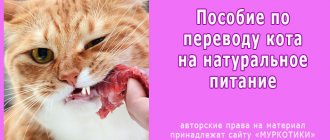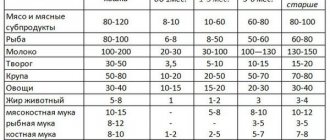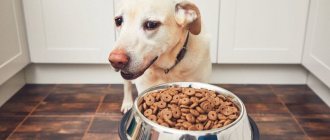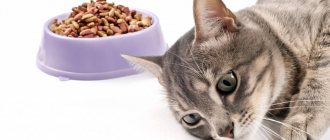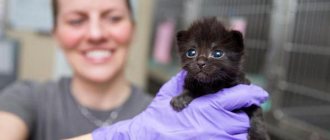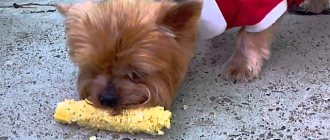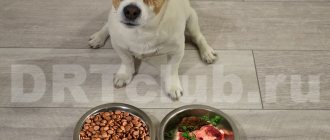The health and well-being of pets depends on compliance with the norm of cat food. Failures in food intake can lead to pathological conditions - anorexia or obesity, lead to metabolic disorders and a decline in immunity. Feeding rates vary depending on the breed of the cat, its weight and activity. Healthy feeding rules will help avoid diseases and ensure the normal development of the animal.
The importance of proper nutrition
It happens that owners realize the importance of proper nutrition for their pet only when its health begins to deteriorate. In such cases, it is necessary to urgently change her diet, even if it is a little late.
Especially if this happens during a period of intensive growth and development of the cat’s body. A caring and loving owner should know what and how much to feed a cat as soon as he decides to take it into his home.
A properly selected diet and nutrition regimen, organized for a pet from an early age, ensures the animal a long and healthy existence.
Eating improperly leads to problems in the functioning of many organs and systems. The most common complications occur with the following organs:
- Kidneys;
- Gastrointestinal tract;
- Teeth;
- Joints.
Urolithiasis and allergies may also develop.
Feeding frequency
Proper nutrition includes not only balanced food, but also optimal feeding frequency. The pet’s mood and the health of its body depend on the daily norm. Feeding at regular times reduces the risk of obesity and normalizes digestion.
In addition, with a strict food intake regime, you can assess the cat’s appetite and then make adjustments to the amount of food consumed. In addition, dispensing feed at the scheduled time will prevent food spoilage, especially in hot weather.
How many times a day should you feed your cat?
- At the age of 2 to 3 months - 4-5 times (180-200 g);
- From 4 to 5 months - 3-4 times (240 g);
- From six months - 3 times (240 g);
- Adults - 2 times (200–250 g).
How to tell if your pet has enough food
The daily food intake recommended by experts for pets of different ages may not always be suitable for each individual animal. You can determine whether your cat's daily amount of food is sufficient by observing her for some time. If a pet is malnourished, it constantly searches for food, loses weight, and its fur becomes dull and falls out. In this case, the amount of food can be increased slightly. As a rule, healthy, balanced animals do not overeat. Neutered cats can be prone to gluttony.
To control your pet's weight, you need to practice regular weighing. A three-month-old kitten should weigh approximately 1700–2300 grams, a four-month-old kitten should weigh from 2500 to 3500 grams, and a five-month-old kitten should weigh 3–4 kilograms. Females usually weigh less than males, and the norm of the animal’s weight also depends on the breed. For example, a male "British" at the age of 12 months should weigh from 4.5 to 7 kg, and a female - 2.5-4.7 kg. The weight of a Maine Coon cat at the same age should range from 5.9 to 9 kg, and of cats - from 4.5 to 7.5 kg.
You can determine how well-fed an animal is without weighing. To do this you need to palpate his body. If the ribs cannot be felt, then most likely the pet’s weight exceeds the norm.
Ready food
At the moment, there are many different ready-made foods; most owners choose this particular feeding option.
- Since not everyone has time to prepare healthy food from natural products.
- In ready-made food, all ingredients are balanced and provide everything necessary for the pet’s body.
Rating
All wet canned food for cats can be divided into four classes: economy, premium, super-premium and holistic. It is clear that the meat content in them increases in ascending order. But not all cat lovers can afford anything other than economy class.
Popular brands of economy-class canned food: “Kiteket”, “Whiskas”, “Night Hunter”, “Felix”.
If we talk about the best wet food among the most budget options, then in terms of protein content, the leader, unsurprisingly, is Night Hunter. Felix is in second place.
In the premium segment, popular brands include Sheba, Proplan, Gourmet, Royal Canin, and Brit. Sheba, Proplan and Brit have approximately the same protein content - 30–34%.
Super-premium class includes foods such as Pronature Original, Gina, Bozita and others. If you choose them for your pet, then you don’t have to worry about making a mistake - they are all approximately the same in composition and the presence of nutrients.
The best foods in the holistic segment are Innova, Acana, Almo Nature, Farmina N&D, Pronature Holistic, Orijen. They are very expensive and contain a large percentage of meat.
Dry food
Ready-made foods produced by different companies have different nutritional properties. Most often, the packaging indicates the weight and age of the pet for which the food is intended, as well as the recommended amount of the product.
Dry food mainly consists of a mixture that includes:
- Meat products;
- Cereals;
- Plant products.
All this is dried using a special method. This food is very convenient because you can safely leave it in a bowl if the cat is left at home alone for a long time. There is no way to visually determine the composition of the granules. Therefore, when choosing a brand of food, you need to know the product category and give preference to premium and super-premium.
A little history
The production of pet food dates back to 1860. Then a simple American electrician named Spratt came up with a dog pie, which included wheat, vegetables and beef blood.
Probably, from these times the myth began that all food for cats and dogs is made from waste: horns and hooves, as well as sawdust or soybeans (at best).
Nowadays, a variety of multi-colored bags allows you to choose pate, jelly, and pieces in sauce for your pet.
Wet food
They can be in the form of pouch bags and canned food with pate or stew.
- Pouches are sold in bags of 85 and 100 g.
- The food in them consists of pieces of meat in sauce, with the addition of cereals and plant products.
In addition to vegetables, fish and meat, the products contain added vitamins and minerals. Therefore, this food is a complete nutrition of proper quality.
Sterilized
It doesn’t matter whether it is a Scottish Fold or a Scottish Straight, or even a Siberian, Scottish or Thai breed, it is important to take the daily nutrition of a sterilized cat with special responsibility, especially in the first days after the operation. Choose industrial feed with special labeling. However, veterinarians cannot rule out natural food, which should be properly composed of boiled fish and lean meats. The presence of grains and vegetables to feed the cat is appropriate only in minimal doses.
Daily norm
Conscientious food manufacturers indicate on the packaging information about the recommended daily intake, which depends on the weight and age of the pet.
It is worth noting that if the norm is small, then the product is saturated with nutrients. The average volume of wet food is 5% of the pet’s weight.
Approximately how many times per day to feed an adult cat with ready-made food based on the weight of the animal:
- Up to 3kg - 25g;
- From 3 to 4 kg - 40g;
- From 4 to 5 kg - 55–65 g;
- From 5kg - 12g per 1kg of weight.
Kittens that weigh less than two kilograms per day need 35 grams of food, and those weighing from 2 to 3 kg need 50 grams of food.
For pregnant and lactating cats, the amount of food should be doubled. That is, if a female weighs 4-5 kg, then she will need 100–130 g per day.
When switching your pet to another type of food, you need to gradually mix a new one into the usual food, each time increasing the volume of the new food.
When he was born
Feeding a newborn kitten is perhaps the only topic in nutrition that does not concern you at all.
His mother knows the answer to this question. But it happens that people also have to feed babies, for example, foundlings.
So what do you need to know if a baby is dropped at your door, or for some other reason, feeding a kitty falls on your shoulders.
- A newborn cannot drink on his own, so you need to stock up on an ordinary medical syringe.
- Formulas for newborns are sold especially for refuseniks. Just like people. This mixture has a composition as close as possible to the composition of milk from a nursing cat. You can buy it at a pet store
- If you can’t buy the mixture, the food can be prepared at home. Goat and cow's milk are mixed in equal proportions, then egg white is added. The resulting mixture is filtered and heated to 30 degrees
- In order for the baby to be full, he needs to be fed every 2 hours, day and night.
A signal that the baby is completely full will be his quiet sleep. If after feeding the baby squeals, then eating should be continued.
Natural diet
It is not easy to create a complete diet from natural products; this requires following some rules and being patient.
- Cats are naturally conservative, so they do not require a varied diet.
- Once you set the correct diet, you can use it constantly.
It is worth considering that to maintain and preserve the health of the animal, free access to water is very important, which needs to be changed twice a day.
Water in the diet
Water should be present in the bowl at all times, and it should be clean, especially if the pet eats dry food.
- With a natural diet, the cat requires less fluid, but still needs it.
- You can determine whether your pet has enough fluid by looking at its fur and the frequency of urination.
If the coat is silky and shiny, and its owner is active and empties at least twice a day, then this means that the diet contains enough fluid.
Increasing and decreasing dosage
How much dry food should be given to cats also depends on changing quantities that can be missed.
Physical activity
A pet can eat more abundantly if it does not lie on the couch in front of the TV for days on end: it can frolic in the room, it is played with and trained. Homebodies are in the same microclimate all year round, but for those who regularly walk and, say, live in a house with a yard, supplementation is essential in the cold season. In nature, natural hunters rest less, are constantly moving and will not be able to recover without training.
Age
A growing fidget does not save energy. Starting from three to four months, adolescents absorb the same amount of food as adults. When a family friend reaches seven years of age, adjustments are made and the edible quota is reduced.
Homeostasis after castration or sterilization
Losing the characteristic level of testosterone, males are prone to urolithiasis. Such individuals buy foods with a rich content of polysaccharides and legnin and reduced fat content. To prevent turning into an obese lazy person, the cat is given special attention: they play for a long time and are taken for a walk.
Pregnancy and lactation
In the second week of gestation, females increase the norm by 15%, and in the third - up to 50. The type of food remains the same, but with the addition:
- calcium;
- vitamins A, E and K;
- fiber.
The issue is resolved by switching to a specialized version from a familiar manufacturer. Well-known companies have a variety of product lines in their assortment and finding the right one is not difficult.
Before giving birth, animals usually refuse to eat. This is a natural and harmless reaction - there is no need to force it.
External factors
The diet is recommended for those who are injured, sick or under stress. They are given delicate, easily digestible food. When choosing a table in such cases, they try to purchase a gentle, lean substitute. The approach is also recommended when the person is overtired, after a long transportation or a powerful load on the musculoskeletal system.
Example of an optimal menu
If you are short on time, you can prepare mixtures that are sufficiently nutritious and balanced in advance and freeze them. There are recipes approved by experts, of which the most simple ones can be distinguished.
From meat, buckwheat or rice and vegetables:
- Beef - 2kg;
- Vegetables - 500 g (they are boiled separately).
- Cereals - 200g;
Grind everything in a meat grinder and freeze in portions.
From chicken fillet:
- Chicken fillet - 1 kg;
- Vegetables - 150g.
- Boiled rice - 100g;
Pass everything through a meat grinder, form into balls and boil. After the meatballs have cooled, they need to be frozen.
In addition to main dishes, a cat’s daily diet should include about 30 grams of fermented milk products.
The choice of type of feeding for a pet depends on the owner, his capabilities and preferences. Each food has its own advantages and disadvantages. A caring owner will, if desired, find the best option for his pet.
Neutered cat
After surgery, nutrition must be balanced in order to restore the animal’s resource. There are several options for how to feed a cat after castration, but it is recommended to focus on changing the volume of daily portions. Immediately after the operation, each meal should be halved, while fasting days should be arranged regularly. If the cat eats a full portion, do not give supplements; it is better to increase the daily number of meals. The basis of the diet is boiled young beef and fermented milk products.


